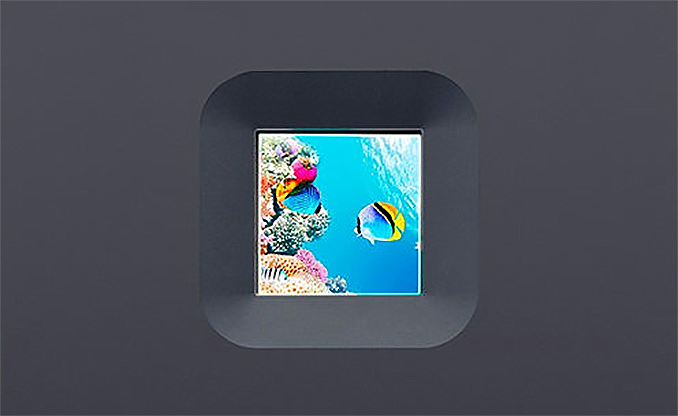Japan Display Develops 1.6-Inch Micro LED Display Module: 265 PPI & 3,000 Nits
by Anton Shilov on December 2, 2019 4:00 PM EST
Japan Display Inc. (JDI) announced this week that it has completed development of its first Micro LED module. The prototype of the Micro LED module, which is a potential building block for next generation displays and TVs, offers a 265 PPI pixel density. JDI will be demonstrating the module at Fintech Japan 2019 later this week.
JDI’s Micro LED display prototype is a square module with a 1.6-inch diagonal, and offers a resolution of 300×300 pixels along with a maximum brightness of 3,000 nits. The prototype uses gallium nitride LED chips developed by glo (a Micro LED pioneer) and JDI’s LTPS backplane.
| JDI's Micro LED Display Module Prototype | |||
| Feature | Characteristic | ||
| Screen size | 1.6 inches | ||
| Resolution | 300×300×RGB | ||
| Pixel density | 265 PPI | ||
| Luminance | 3,000 cd/m² | ||
| Viewing angle | >178° | ||
As part of the development process for Micro-LED displays, the hope is that display makers can assemble full-sized displays by building them out of individual modules such as JDIs. A modular approach not only offers more control over yields (as opposed to having to fail a full-sized panel over a flaw), but it would also allow manufacturers to easily support multiple resolutions and aspect ratios just by changing the number of modules. That said, being able to produce commercial panels in volume is still years off, and for now Japan Display has made significant progress just in completing their prototype module.
Micro LED technology is a promising candidate for higher-end displays and television that will be available three to four years down the road. The technology has virtually all the quality advantages that OLED has to offer (over LCD), including individually-controlled LEDs, high contrast, fast response times, and wide viewing angles. But equally important, it does not come with the major disadvantages that OLEDs are known for, such as off-axis color shifting and aging-related burn-in. There are many small companies working on Micro LED technology, but so far only a handful of actual displays/TVs manufacturers have showcased their Micro LED prototypes, and only two of them have started to commercialize this technology on a very small scale.
Related Reading:
- TCL Shows Off 132-Inch Micro LED 4K UHDTV: 24,000,000 Micro LEDs
- Samsung’s Micro LED Wall TVs Now Available: Up to 8K, Up to 292-Inches
- Sony’s Micro LED-Based Ultra-HD TVs Available to Consumers: 2K to 16K Resolutions, up to 790-Inches
- Chinese and Taiwanese Companies To Gain Controlling Stake of JDI
- Japan Display Develops VRM-100 VR Headset with 3DOF for Business Users
Source: Japan Display










29 Comments
View All Comments
GC2:CS - Monday, December 2, 2019 - link
That is just enough for an Apple Watch...michael2k - Monday, December 2, 2019 - link
That's exactly what I thought! Or possibly a more expensive iPhone SE, if they can get it scaled up to a 4" screenp1esk - Monday, December 2, 2019 - link
But not enough PPI for any VR headset... Also, isn't 3000 nits insanely bright? Why is this thing so bright?DanNeely - Monday, December 2, 2019 - link
high end HDR support. IIRC the current specs define up to 10k (ex for the sun or other very small bright reflections) as a future tech target. Probably also as a demonstration of how high they can push the techs performance. This should have OLED blacks, but also be able to get brighter than the best consumer LCD displays.tuxRoller - Monday, December 2, 2019 - link
The sun is closer to 150k.Valantar - Tuesday, December 3, 2019 - link
Nobody is saying it should try to emulate the sun's actual brightness, just that extreme brightness levels like 3000 nits are useful for displaying very bright things _like_ the sun.futrtrubl - Tuesday, December 3, 2019 - link
Plus nobody would actually want it that bright. Think of the liability for retinal damage.tuxRoller - Tuesday, December 3, 2019 - link
I was directly replying to this:"IIRC the current specs define up to 10k (ex for the sun or other very small bright reflections)"
While there may be some use for a spec that covers the entire human visual luminance range (scotopic + mesoscopic + photopic), that's not what I was advocating (https://hdguru.com/calibration-expert-is-10000-nit...
TBC: 10k isn't equal to peak solar luminance, nor the maximum that a human eye can tolerate without damage (typically).
ZolaIII - Monday, December 2, 2019 - link
It's a early prototype to show how far it can go. It won't go commercially neither that bright nor with that density nor it will remain to be Gallium nitrate solely based we will probably see switch to Indium Gallium Zinc oxide (IGZO) LED's along with further miniaturisation.CharonPDX - Monday, December 2, 2019 - link
Probably for use in a projection setting.